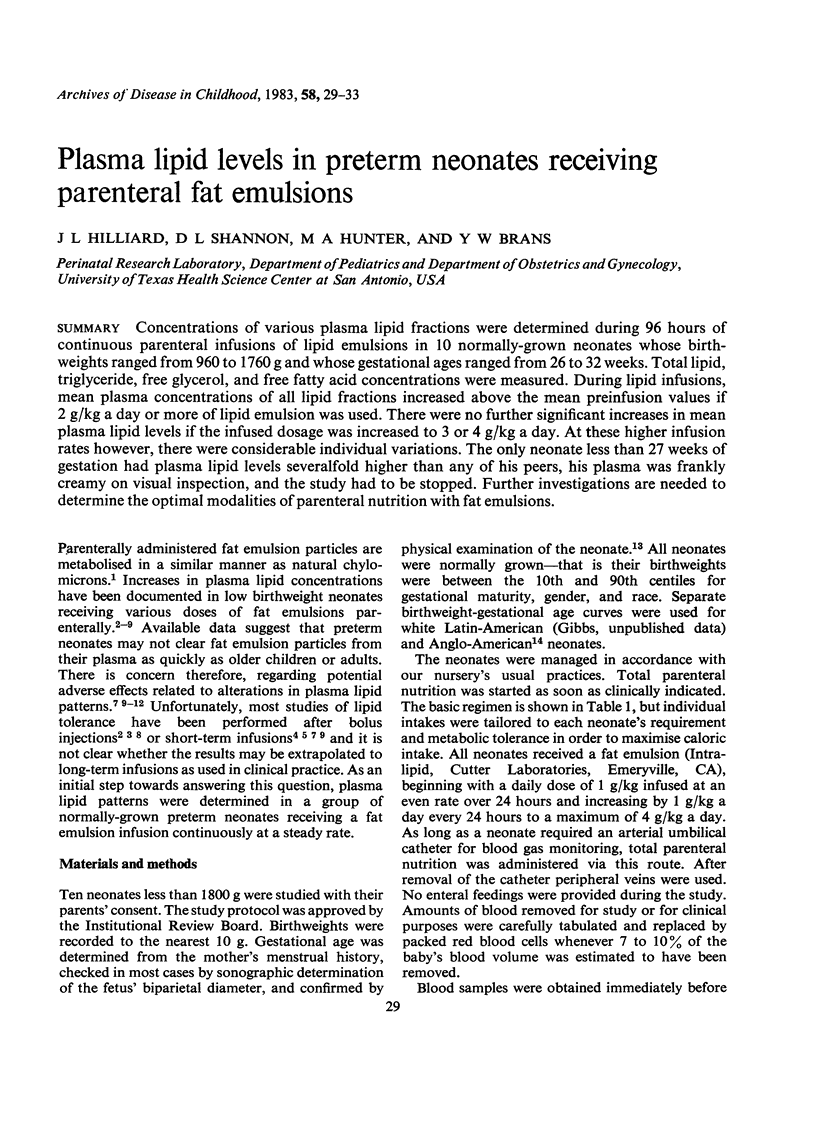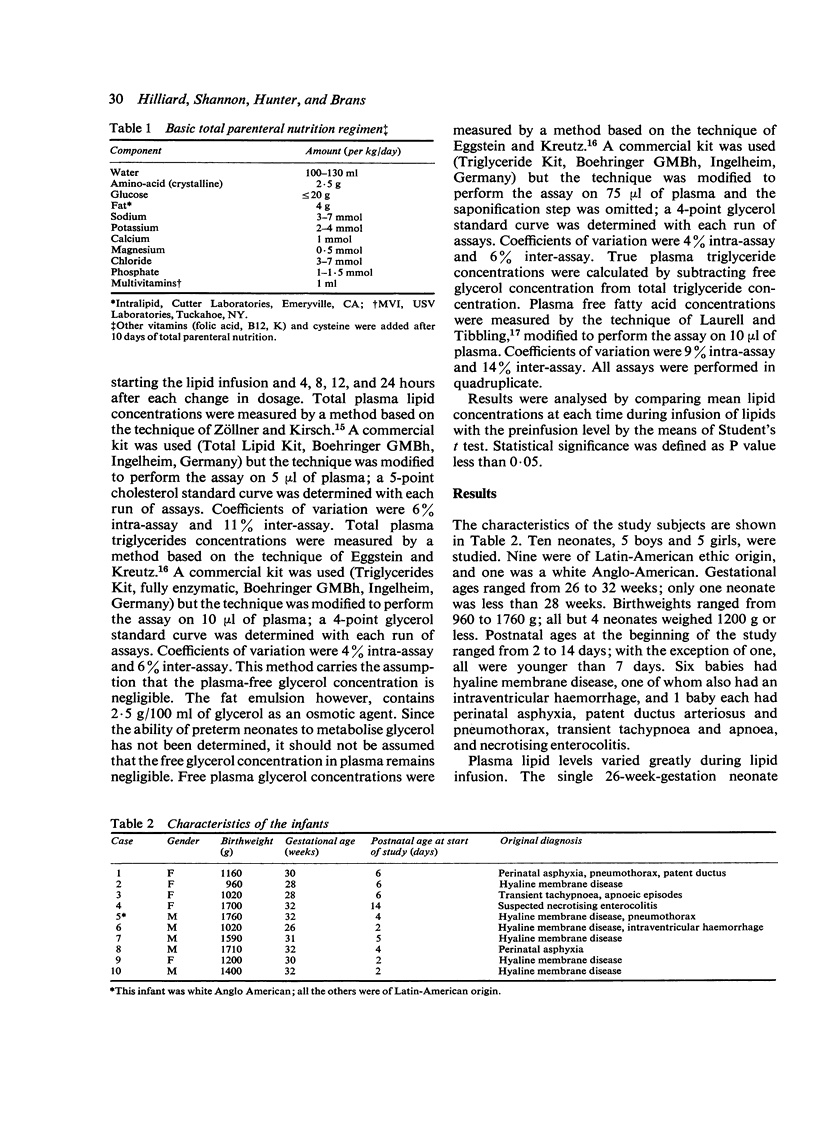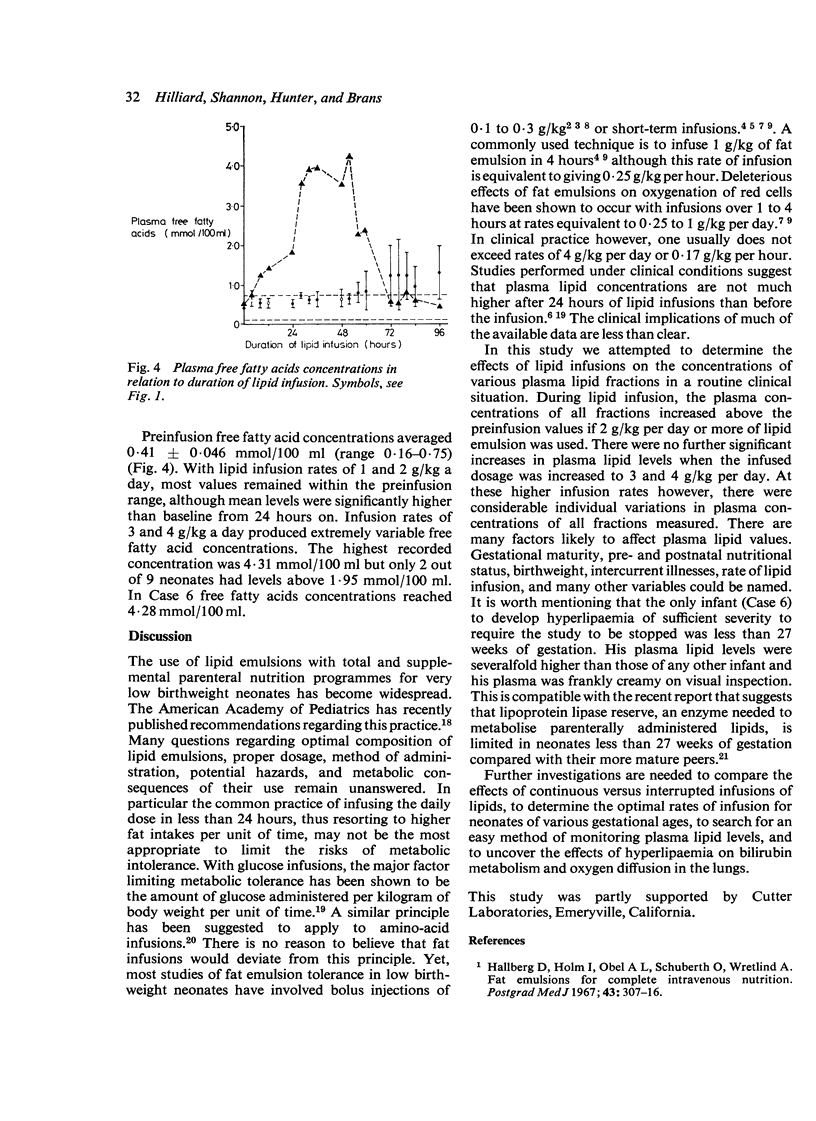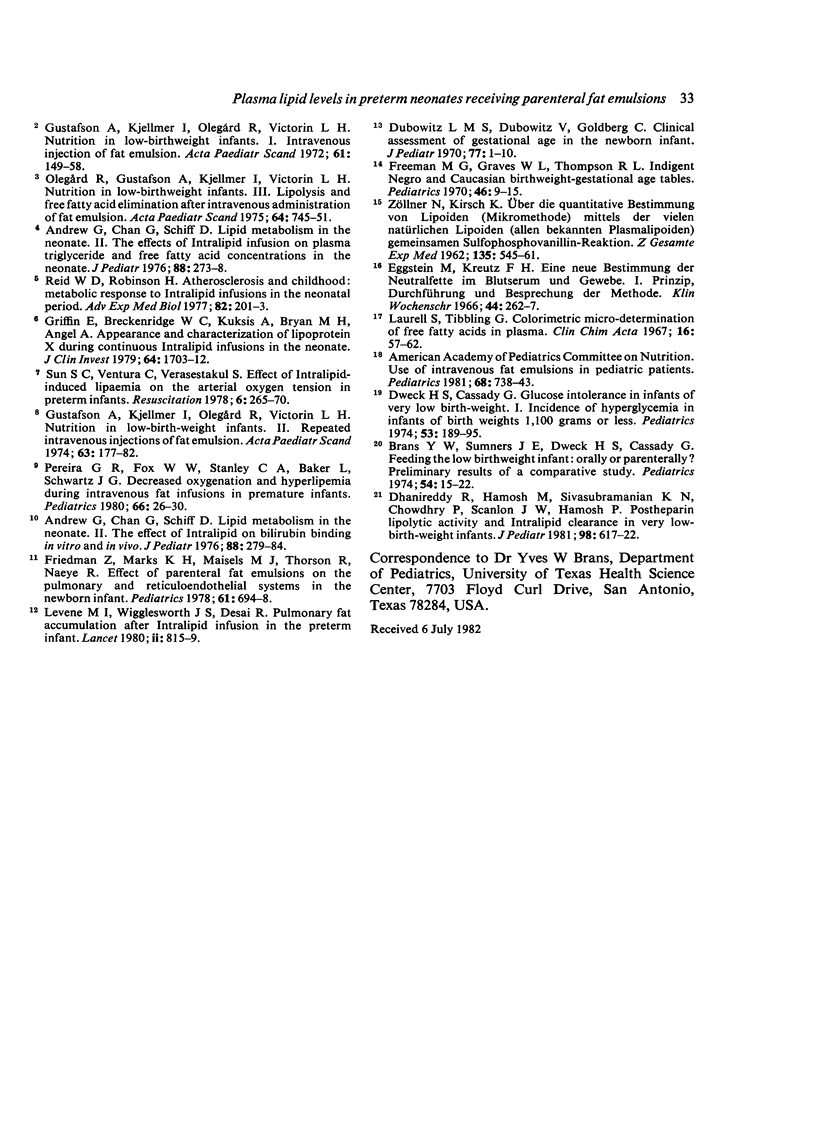Abstract
Concentrations of various plasma lipid fractions were determined during 96 hours of continuous parenteral infusions of lipid emulsions in 10 normally-grown neonates whose birth-weights ranged from 960 to 1760 g and whose gestational ages ranged from 26 to 32 weeks. Total lipid, triglyceride, free glycerol, and free fatty acid concentrations were measured. During lipid infusions, mean plasma concentrations of all lipid fractions increased above the mean preinfusion values if 2 g/kg a day or more of lipid emulsion was used. There were no further significant increases in mean plasma lipid levels if the infused dosage was increased to 3 or 4 g/kg a day. At these higher infusion rates however, there were considerable individual variations. The only neonate less than 27 weeks of gestation had plasma lipid levels severalfold higher than any of his peers, his plasma was frankly creamy on visual inspection, and the study had to be stopped. Further investigations are needed to determine the optimal modalities of parenteral nutrition with fat emulsions.
Full text
PDF




Selected References
These references are in PubMed. This may not be the complete list of references from this article.
- Andrew G., Chan G., Schiff D. Lipid metabolism in the neonate. I. The effects of Intralipid infusion on plasma triglyceride and free fatty acid concentrations in the neonate. J Pediatr. 1976 Feb;88(2):273–278. [PubMed] [Google Scholar]
- Andrew G., Chan G., Schiff D. Lipid metabolism in the neonate. II. The effect of Intralipid on bilirubin binding in vitro and in vivo. J Pediatr. 1976 Feb;88(2):279–284. [PubMed] [Google Scholar]
- Brans Y. W., Sumners J. E., Dweck H. S., Cassady G. Feeding the low birth weight infant: orally or parenterally? Preliminary results of a comparative study. Pediatrics. 1974 Jul;54(1):15–22. [PubMed] [Google Scholar]
- Dhanireddy R., Hamosh M., Sivasubramanian K. N., Chowdhry P., Scanlon J. W., Hamosh P. Postheparin lipolytic activity and Intralipid clearance in very low-birth-weight infants. J Pediatr. 1981 Apr;98(4):617–622. doi: 10.1016/s0022-3476(81)80777-9. [DOI] [PubMed] [Google Scholar]
- Dubowitz L. M., Dubowitz V., Goldberg C. Clinical assessment of gestational age in the newborn infant. J Pediatr. 1970 Jul;77(1):1–10. doi: 10.1016/s0022-3476(70)80038-5. [DOI] [PubMed] [Google Scholar]
- Dweck H. S., Cassady G. Glucose intolerance in infants of very low birth weight. I. Incidence of hyperglycemia in infants of birth weights 1,100 grams or less. Pediatrics. 1974 Feb;53(2):189–195. [PubMed] [Google Scholar]
- Eggstein M., Kreutz F. H. Eine neue Bestimmung der Neutralfette im Blutserum und Gewebe. I. Prinzip, Durchführung und Besprechung der Methode. Klin Wochenschr. 1966 Mar 1;44(5):262–267. doi: 10.1007/BF01747716. [DOI] [PubMed] [Google Scholar]
- Freman M. G., Graves W. L., Thompson R. L. Indigent Negro and Caucasian birth weight-gestational age tables. Pediatrics. 1970 Jul;46(1):9–15. [PubMed] [Google Scholar]
- Friedman Z., Marks K. H., Maisels J., Thorson R., Naeye R. Effect of parenteral fat emulsion on the pulmonary and reticuloendothelial systems in the newborn infant. Pediatrics. 1978 May;61(5):694–698. [PubMed] [Google Scholar]
- Griffin E., Breckenridge W. C., Kuksis A., Bryan M. H., Angel A. Appearance and characterization of lipoprotein X during continuous intralipid infusions in the neonate. J Clin Invest. 1979 Dec;64(6):1703–1712. doi: 10.1172/JCI109633. [DOI] [PMC free article] [PubMed] [Google Scholar]
- Gustafson A., Kjellmer I., Olegård R., Victorin L. H. Nutrition in low-birth-weight infants. II. Repeated intravenous injections of fat emulsion. Acta Paediatr Scand. 1974 Mar;63(2):177–182. doi: 10.1111/j.1651-2227.1974.tb04780.x. [DOI] [PubMed] [Google Scholar]
- Gustafson A., Kjellmer I., Olegård R., Victorin L. Nutrition in low-birth-weight infants. I. Intravenous injection of fat emulsion. Acta Paediatr Scand. 1972 Mar;61(2):149–158. doi: 10.1111/j.1651-2227.1972.tb15919.x. [DOI] [PubMed] [Google Scholar]
- Hallberg D., Holm I., Obel A. L., Schuberth O., Wretlind A. Fat emulsions for complete intravenous nutrition. Postgrad Med J. 1967 Apr;43(498):307–316. [PMC free article] [PubMed] [Google Scholar]
- Laurell S., Tibbling G. Colorimetric micro-determination of free fatty acids in plasma. Clin Chim Acta. 1967 Apr;16(1):57–62. doi: 10.1016/0009-8981(67)90269-0. [DOI] [PubMed] [Google Scholar]
- Levene M. I., Wigglesworth J. S., Desai R. Pulmonary fat accumulation after intralipid infusion in the preterm infant. Lancet. 1980 Oct 18;2(8199):815–818. doi: 10.1016/s0140-6736(80)90170-1. [DOI] [PubMed] [Google Scholar]
- Olegård R., Gustafson A., Kjellmer I., Victorin L. Nutrition in low-birth-weight infants. III. Lipolysis and free fatty acid elimination after intravenous administration of fat emulsion. Acta Paediatr Scand. 1975 Sep;64(5):745–751. doi: 10.1111/j.1651-2227.1975.tb03914.x. [DOI] [PubMed] [Google Scholar]
- Periera G. R., Fox W. W., Stanley C. A., Baker L., Schwartz J. G. Decreased oxygenation and hyperlipemia during intravenous fat infusions in premature infants. Pediatrics. 1980 Jul;66(1):26–30. [PubMed] [Google Scholar]
- Reid W. D. Metabolic response to intralipid infusions in the neonatal period. Adv Exp Med Biol. 1977;82:201–203. doi: 10.1007/978-1-4613-4220-5_39. [DOI] [PubMed] [Google Scholar]
- Sun S. C., Ventura C., Verasestakul S. Effect of Intralipid-induced lipaemia on the arterial oxygen tension in preterm infants. Resuscitation. 1978;6(4):265–270. doi: 10.1016/0300-9572(78)90007-2. [DOI] [PubMed] [Google Scholar]


